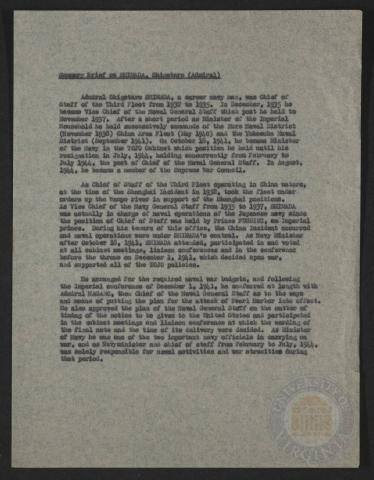
Page 1
| Parent | Summary Brief about Shigetaro Shimada |
|---|---|
| Date | |
| Language | English |
| Collection | Roy L. Morgan Papers |
| Box | Box 3 |
| Folder | 1946 [IMFTE] (IPS) Translations of interrogations. |
| Repository | University of Virginia Law Library |
Summary Brief SHIMADA, Shigetaro (Admiral)
Admiral Shigetaro SHIMADA, a career navy man, was Chief of Staff of the Third Fleet from 1932 to 1935. In December, 1935 he became Vice Chief of the Naval General Staff which post he held to November 1937. After a short period as Minister of the Imperial Household he held successively commands of the Kure Naval District (November 1938) China Area Fleet (May 1940) and the Yokosuka Naval District (September 1941). On October 18, 1941, he became Minister of the Navy in the TOJO Cabinet which position he held until his resignation in July, 1944, holding concurrently from February to July 1944, the post of Chief of the Naval General Staff. In August, 1944, he became a member of the Supreme War Council.
As Chief of Staff of the Third Fleet operating in China waters, as the time of the Shanghai Incident in 1932, took the fleet under orders up the Wampo River in support of the Shanghai positions. As Vice Chief of the Navy General Staff from 1935 to 1937, SHIMADA was actually in charge of naval operations of the Japanese navy since the position of Chie of Staff was held by Prince FUSHIMI, an Imperial prince. During his tenure of this office, the China Incident occurred and naval operations were under SHIMADA’s control. As Navy Minister after October 18, 1941, SHIMADA attended, participated in and voted at all cabinet meetings, liaison conferences and in the conference before the throne on December 1, 1941, which decided upon war, and supported all of the TOJO policies.
He arranged for the required naval war budgets, and following the Imperial conference of December 1, 1941, he conferred at length with Admiral NAGANO, then Chief of the Naval General Staff as to the ways and means of putting the plan for the attack of Pearl Harbor into effect. He also approved the plan for the attack on Pearl Harbor into effect. He also approved the plan of the Naval General Staff on the matter of timing of the notice to be given to the United States and participated in the cabinet meetings and liaison conference at which the wording of the final note and the time of its delivery were decided. As Minister of Navy he was one of the two important navy officials in carrying on war, and as Navy minister and chief of staff from February to July, 1944, was solely responsible for naval activities and war atrocities during that period.
